6 SEA (Socially Engaged Art) Project: Social Inequality
The Process
Group discussions:
- First meeting was awkward, we didn’t know what to do and the instructions were vague. We decided to start with an overall question- “How much ____ would you be able to buy with a dollar now, compared to (what ever year)”. This was a good base to start with, we would eventually change the question to something else that would fit our research and theme.
- Scheduling another meeting where most of us could show up was also a bit of a tricky situation because we had other classes, personal lives, and festival groups to deal with. We settled with meeting up Thursday morning and communicating mostly through Discord.
In the beginning stages of our discussions, we floated the idea of making a video. It seemed like an effective way to mention relevant data alongside graphics if we decided to create a visual art project. However, our expertise in video editing was lacking and wouldn’t allow us to utilize the medium to its full potential, so we ultimately decided against it.
About the Project
To organize our ideas and research, we decided to use Google Slides. Each slide was categorized by topic, which included minimum wage in the US, the top 1%, and economic disparities. At the beginning of the presentation, we had an Audience Contribution section where we asked the question, “If you woke up and were part of the top 1% (making ≥$540,000/yr), what would be the first thing you do with the money?” This was the same question we posed to the class in a previous discussion board, so we had a general idea of the kinds of answers we would get and how the conversation could progress from that point.
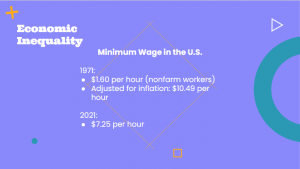
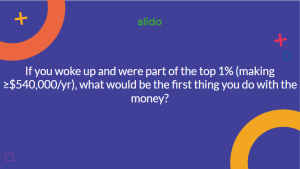
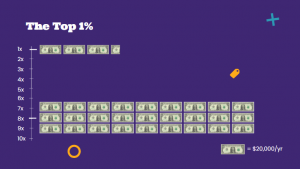
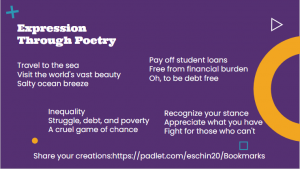
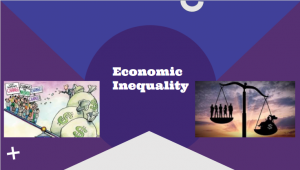
The Presentation
The moments leading up to our presentation were fairly nerve racking. We were originally allotted 5-8 minutes to present but due to some outside complications, our time was cut short. Some of our talking points had to be cut, including the audience interaction activity, but we made sure to summarize key ideas. This included slides of background information about minimum wage and disparities between the top 1% and the median US household income, as well as a brief overview of our artistic component. The original plan was to have participants answer a survey question, then use those responses to create haikus. Poetry felt like a fitting creative medium for this project because it showcases a balance between words and flow, similarly to the ideas we were trying to present about economic inequality. A quote from this section’s talking points was, “We felt that the balance of this poetic form could connect to our topic of economic inequality, as we seek ways to bring balance and equity to this [economic] system.”
Talking Points:
- Before we begin, I’d like to take a moment to recognize all of the previous projects and performances that have been shown today, and to thank all of you for being such wonderful, receptive audience members. It’s been a long journey so far, so I will try my best to keep this short and direct.
- We would like to begin our conversation by discussing minimum wage in the United States. As some may be aware, there have recently been calls to raise the minimum wage to $15 per hour. The current minimum wage is $7.25, which has been argued to not be sustainable for the cost of living (which has been increasing). For comparison, 50 years ago in 1971 was $1.60 (which equals $10.49 after adjusting for inflation)
- That is almost 8 times more than the median US household income
- Median US household income – 68,000/yr
- Top 1% US income – 540,000/yr
- In this section, we invite audience members to imagine themselves in the position of the top 1%. It is a lifestyle that feels out of reach for most people, and the gap between only feels further and further as time progresses. We surveyed some of our classmates and asked the question: [question]
- Haiku is a Japanese form of poetry that consists of only 17 syllables (5-7-5). Its structure is designed to emphasize brief, but expressive language despite the restriction of syllables. We felt that the balance of this poetic form could connect to our topic of economic inequality, as we seek ways to bring balance and equity to this system.
- In this activity, we would like audience members to form their responses from the previous question into a haiku
Citations:
“History of Changes to the Minimum Wage Law.” U.S. Department of Labor, https://www.dol.gov/agencies/whd/minimum-wage/history. Accessed 24 Feb. 2021.
“CPI Inflation Calculator.” U.S. Bureau of Labor Statistics, https://www.bls.gov/data/inflation_calculator.htm. Accessed 24 Feb. 2021.
Sykes, Bryan L., and Michelle Maroto. “A Wealth of Inequalities: Mass Incarceration, Employment, and Racial Disparities in U.S. Household Wealth, 1996 to 2011.” RSF: The Russell Sage Foundation Journal of the Social Sciences, Oct. 2016, https://doi.org/10.7758/RSF.2016.2.6.07. Accessed 24 Feb. 2021.
“Economic Disparity.” Esri, https://www.arcgis.com/apps/Cascade/index.html?appid=412c5cb6fae5487998e290160ddce056. Accessed 24 Feb. 2021.
